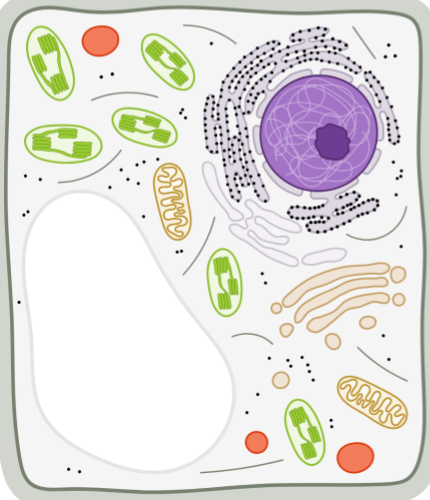
Identify the given image
A)Animal cell
B)Amoeba
C)Plant cell
D)All of the above


Answer
442.2k+ views
Hint: In all organisms, the cell is the essential unit of life. Like humans and animals, some cells are also made of plants. A cell wall that is involved in providing form to the plant cell surrounds the plant cell. There are other organelles, apart from the cell wall, that are associated with various cellular activities.
Complete answer:
Plant cells are eukaryotic cells that differ from other eukaryotic species in certain fundamental variables. Along with identical organelles, all plant and animal cells produce nuclei. The presence of a cell wall outside the cell membrane is one of the distinctive features of a plant cell.
At least one eukaryotic cell is produced from animals, fungi, and protists. In addition, a single prokaryotic cell is made up of bacteria and archaea. Plant cells are distinguished by their cell walls, chloroplasts, and central vacuoles from the cells of other species.
Chloroplasts are organelles essential to the work of plant cells. These are the mechanisms that carry out photosynthesis, producing glucose using the energy from the light. The cells use carbon dioxide in doing so, and they release oxygen.
Hence, the correct answer is option (C)
Note: The building blocks of plants are plant cells. The main role carried out by plant cells is photosynthesis.
In the chloroplasts of plant cells, photosynthesis occurs. It is the mechanism by which plants prepare food by the use of sunlight, carbon dioxide and water. In the process, energy is manufactured in the form of ATP.
Complete answer:
Plant cells are eukaryotic cells that differ from other eukaryotic species in certain fundamental variables. Along with identical organelles, all plant and animal cells produce nuclei. The presence of a cell wall outside the cell membrane is one of the distinctive features of a plant cell.
At least one eukaryotic cell is produced from animals, fungi, and protists. In addition, a single prokaryotic cell is made up of bacteria and archaea. Plant cells are distinguished by their cell walls, chloroplasts, and central vacuoles from the cells of other species.
Chloroplasts are organelles essential to the work of plant cells. These are the mechanisms that carry out photosynthesis, producing glucose using the energy from the light. The cells use carbon dioxide in doing so, and they release oxygen.
| Organelle | Structure | Function | Kind of cell |
| Cell membrane | Surrounds the cytoplasm and other organelles | Helps to get rid of waste and helps in entry and exit of things | Both plant and animal cell |
| Cell wall | Rigid | Provides protection and support | Only in plant cell |
| Nucleus | Houses chromosomes and DNA | Controls and informs other organelles what is to be done | Both plant and animal cell |
| Cytoplasm | Liquid Gel that fills the cell | It provides suspension to organelles to move around easily | Both animal and plant cells |
| Mitochondria | It is a double membrane organelles with inner fold | It converts glucose into energy that is needed by the body | Both plant and animal cells |
| Chloroplasts | It is filled with chlorophyll and contains discs of sacs | Site for photosynthesis by which plants make their own food. | Only in plant cell |
| Vacuole | Larger in plant cell than animal cell | Stores nutrients , water and other minerals | Both animal and plant cell |
| Lysosome | Small spherical organelle with enzyme | Digest old cell parts and helps in removing waste | Some plant and animal cells |
Hence, the correct answer is option (C)
Note: The building blocks of plants are plant cells. The main role carried out by plant cells is photosynthesis.
In the chloroplasts of plant cells, photosynthesis occurs. It is the mechanism by which plants prepare food by the use of sunlight, carbon dioxide and water. In the process, energy is manufactured in the form of ATP.
Recently Updated Pages
Glucose when reduced with HI and red Phosphorus gives class 11 chemistry CBSE

The highest possible oxidation states of Uranium and class 11 chemistry CBSE

Find the value of x if the mode of the following data class 11 maths CBSE

Which of the following can be used in the Friedel Crafts class 11 chemistry CBSE

A sphere of mass 40 kg is attracted by a second sphere class 11 physics CBSE

Statement I Reactivity of aluminium decreases when class 11 chemistry CBSE

Trending doubts
10 examples of friction in our daily life

The correct order of melting point of 14th group elements class 11 chemistry CBSE

Difference Between Prokaryotic Cells and Eukaryotic Cells

One Metric ton is equal to kg A 10000 B 1000 C 100 class 11 physics CBSE

State and prove Bernoullis theorem class 11 physics CBSE

What organs are located on the left side of your body class 11 biology CBSE




